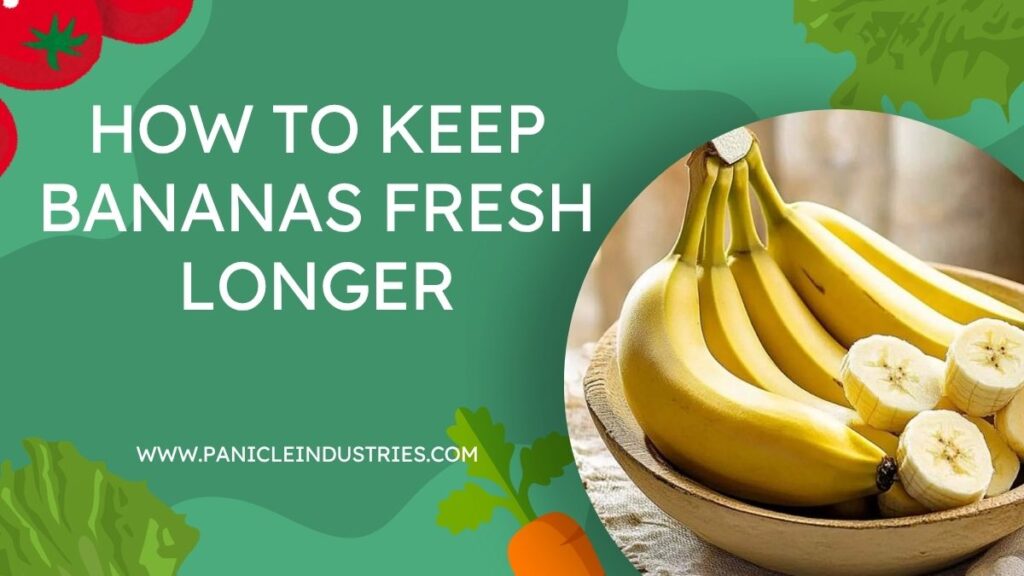Bananas are one of the most popular fruits in the world. They’re tasty, healthy, and easy to carry around. But the only problem is—they ripen too fast! One day they’re perfect, and the next day they’ve turned brown. Many people wonder how to keep bananas fresh longer, especially if they buy them in bulk or want to save them for later. The good news is, there are simple ways to make bananas stay fresh for more days.
In this blog, we’ll talk about easy methods to slow down banana ripening, how to store them properly, and tricks that actually work. Whether you eat bananas daily or occasionally, this guide will help you reduce waste.
Why Do Bananas Ripen So Fast?
Before we talk about how to keep bananas fresh longer, let’s understand why they ripen quickly in the first place.
Bananas produce a natural gas called ethylene. This gas helps fruits ripen. Bananas release a lot of ethylene, which means they ripen faster than many other fruits. When bananas are close together or near other fruits like apples or avocados (which also release ethylene), they ripen even faster.
Temperature and storage also play a role. Warm places make bananas ripen quicker. Once they turn brown or soft, most people throw them away, which leads to waste.
Also read: How Many Oranges Can You Eat a Day?
How to Keep Bananas Fresh Longer
1. Keep Bananas at Room Temperature—But Not Too Warm
If your bananas are still green, leave them at room temperature to ripen. But don’t keep them in a hot area like next to the stove or near sunlight. A cool, dark corner of your kitchen is best. This slows down the ripening process just enough.
Once they start turning yellow, you can move to the next tip.
2. Hang the Bananas
Hanging bananas on a banana hanger or hook is one of the best ways to keep them fresh longer. Why? Because it keeps them away from surfaces that trap moisture and speed up ripening.
When bananas touch countertops or each other, they bruise faster. Hanging them reduces bruising and helps air circulate around them.
3. Wrap the Banana Stems
This is a really useful trick! Take plastic wrap, aluminum foil, or even beeswax wrap and tightly wrap the stem (top part where the bananas are joined). The stem releases the most ethylene gas. By covering it, you slow down how fast that gas spreads.
You can wrap the whole bunch, or even wrap the stems individually if the bananas are already separated.
4. Separate the Bananas
If you’ve bought a bunch and don’t plan to eat them all soon, separate the bananas. When bananas stay attached in a bunch, they ripen faster. Pulling them apart slows this down.
After separating, wrap each stem as mentioned earlier. This extra step can give you two to three more days of freshness.
5. Store Ripe Bananas in the Fridge
Once your bananas are fully ripe (yellow with maybe a few brown spots), put them in the fridge. The peel might turn dark brown or black—but don’t worry! The fruit inside stays firm and sweet for several more days.
The cold temperature slows down ripening inside. Just make sure not to refrigerate green bananas—they won’t ripen properly afterward.
6. Keep Bananas Away From Other Fruits
Remember that bananas give off ethylene gas. So do many other fruits like:
- Apples
- Pears
- Avocados
- Tomatoes
Keeping bananas next to these fruits makes everything ripen faster. To keep bananas fresh longer, store them in a separate bowl or area away from other fruits.
7. Use a Banana Storage Bag
If you eat bananas regularly, consider buying a banana storage bag. These special bags are designed to slow down the ripening process. They’re usually made of fabric or mesh and allow air to flow through.
They’re great if you don’t want to wrap each stem or hang the bananas.
8. Freeze Extra Bananas
If your bananas are getting too ripe and you won’t eat them in time, don’t throw them away—freeze them!
Here’s how:
- Peel the bananas.
- Cut them into slices.
- Place them in an airtight container or freezer bag.
Frozen bananas are perfect for smoothies, baking (like banana bread), or even homemade ice cream. This is a smart way to reduce waste and save money.
9. Try Lemon Juice on Sliced Bananas
If you slice bananas for a fruit salad or snack, they turn brown quickly. To keep them looking fresh, add a few drops of lemon juice. The citric acid helps prevent browning.
You can also use pineapple juice or orange juice if you don’t like the taste of lemon.
10. Don’t Store Bananas in Plastic Bags
Bananas need air. If you seal them in plastic, they ripen faster and can even get moldy. Instead, store them in open bowls or hang them as mentioned earlier.
The only time to use plastic is when wrapping the stems, not the whole banana.
Bonus Tips
- Buy bananas in different ripeness levels. Choose some green and some yellow so they don’t all ripen at once.
- Use ripe bananas for cooking. If one goes too soft, mash it and use it in pancakes, banana muffins, or smoothies.
- Compost the peels. Even if the peel turns brown or black, you can still use the banana inside and compost the rest.
How Long Do Bananas Usually Last?
Here’s a rough guide:
- Room temperature: 2–5 days (depending on ripeness and weather)
- Refrigerated (ripe): 5–7 days (peel turns dark but inside is fine)
- Frozen (peeled and sliced): Up to 3 months
By using the tips above, you can easily extend the life of your bananas by several days.
Conclusion
Bananas ripen quickly, but with the right care, you can make them last much longer. Knowing how to keep bananas fresh longer is useful for anyone who enjoys this tasty fruit. Whether it’s wrapping the stems, storing them in the fridge, keeping them away from other fruits, or freezing them for later, there are many easy and effective ways to reduce waste. You don’t need any fancy tools—just a few simple habits.
Try these tips at home and enjoy fresh bananas for more days. Not only will you save money, but you’ll also enjoy better-tasting fruit and reduce food waste. Keeping bananas fresh has never been this simple!


